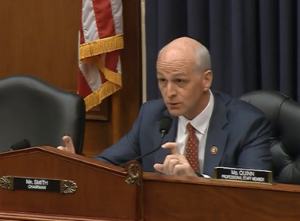The chairman of the House Armed Service Committee Monday said Pentagon technology procurement must improve and grow to help drive U.S. technology innovation, akin to how Special Operational Command (SOCOM) grew in response to the September 11 attacks.
“The Pentagon is built around the idea of spending a massive amount of money on very, very large platforms and they’re not that much focused on innovation and technology,” Rep. Adam Smith (D-Wash.) said during a virtual Information Technology and Innovation Foundation event Monday.

Smith used the analogy of the post-9/11 military changes to SOCOM as it emerged as a main counterterrorism force.
“There’s a long history of how the Special Operations Command was developed, but for the longest time it was secondary, ok. It was a small piece, it was exactly what [the Defense Innovation Unit, DIU] are right now, it was a small piece,” he said.
Smith argued previously SOCOM was used occasionally but the Army and Air Force “were calling the shots, running the show and determining where the money was spent. Well, after 9/11 it was determined that, as Stanley McChrystal said, it takes a network to beat a network…Special Operations was the best trained in this because we wouldn’t be fighting Al Qaeda with 1,000 tanks on the battlefield, it was going to be counterterrorism, counterinsurgency.”
Smith said that kind of innovation helped prevent another large terrorist attack and kept Al Qaeda on the run, and now SOCOM is a much bigger entity and plays a bigger role.
“That’s what we need to do on technology. Get to the point where the procurement people at the Pentagon – this is the 24/7 focus; how do we buy better software.”
Smith used the F-35 Joint Strike Fighter as an example to show DoD is not good at buying software and why that needs to improve.
He said a big reason for “how bad that program is – huge part of it is software. We don’t know how to buy software and the whole friggin’ plane is dependent on software. So it’s got great missiles and other stuff, but the software keeps breaking down and they go to re-do it….we need a SOCOM for buying technology, if you will.”
Smith said officials at the Pentagon are starting to understand his point, citing Air Force Chief of Staff Gen. Charles Brown and Marine Commandant Gen. David Berger. “They get this, and they’re really focused on how to fix this, but it’s a big building, lot of history.
“We’ve got to start moving to get to the point DIU and other organizations are as big as SOCOM, bottom line in terms of really driving how the Pentagon does business.”

Smith also argued DoD must be a prime place in driving innovation and technology, partially because it is where the funding and procurement capability is within government.
He illustrated this by comparing what former Secretary of Defense Mark Esper told him in 2020 about what DoD procurement was vs. the Department of Health and Human Services (HHS) of FEMA in the context of COVID-19 pandemic response capabilities.
“I wanted DoD to be more involved because when you look at testing, getting the PPE out, it was a massive logistical challenge…and you look at what HHS and FEMA did in terms of procurement in a given year and you looked at what DoD did in terms of procurement in a given year – they were better at it. They had the experience, they had the logistics, they knew how to do it.”
“So let’s use them, let’s take advantage of that talent and understanding,” he added.
However, Smith warned part of shifting DoD to improve technology procurement processes is understanding and working through Pentagon and Congress problems.
The Pentagon issue is the stereotypical fighting the last war. Smith said DoD thinks in terms of the last successful war as the first Gulf War, Operation Desert Storm, “where our sheer size and might, our number of platforms overwhelmed our foe.”
That focus led to programs that have had numerous problems, delays and challenges like the F-35, Littoral Combat Ship, DDG-1000 class destroyer, and Ford-class aircraft carrier, Smith argued.
“It was all big and massive and none of it quite worked the way we wanted it to and culturally that’s the way the Pentagon looks at these issues. And also the speed – we’re working on the F-35, the contract was first awarded in 1997. Technology has changed a lot since then, the Pentagon is not in a position to buy as quickly as they need to buy.”
He said the other problem is congressional, which means “for members of Congress, the defense budget is a very simple things: how much money can we take out of it and put back in to our individual districts.”
Therefore, once a large program like the F-35 or the new carrier gets rolling, “you keep funding the program, even if it’s a little bit over budget, even if it’s not quite delivering what you want. It is definitely delivering dollars to your district.
However, Smith said now when rapid innovation is crucial, being so tied to incumbent dollars merely to keep the funds flowing to a district “is really crippling to implement the type of innovation that we need to implement.”
He said there is a major challenge in getting fellow members of Congress to understand the importance of the defense industrial base and using it to improve U.S. technology innovation.
While some members who focus on bringing money to their home district understand adding or shifting DoD funds brings money to some of their districts, he said there is a rising anti-DoD sentiment on the left. Smith divided it into the sentiment the U.S. relies on the military too much to implement foreign policy with Iraq as an example, but also DoD representing excessive militarism and wanting dollars better spent on domestic concerns.
“So I believe that we need to rebuild a bipartisan consensus toward the idea of DoD being a key innovator. And I’ll tell you one of the biggest places we can do this that should bridge that gap is on climate change. I mean, DoD is investing a ton…of money in new battery technology for one thing…So I think there is room to sort of build a new bipartisan consensus on this issue to fight back against some of the anti-defense stuff that’s going on.”